ALREADY REGISTERED OR A PAID SUBSCRIBER? SIGN IN
ALREADY A PAID SUBSCRIBER? SIGN IN
Molly is having a moment. One that has been building in anticipation since the shoots rudely broke ground at the end of winter. Lipstick-pink sheaths, bright as forced rhubarb, then smoky growth with its downy bloom like plums. Fists clenched and reaching fast in March letting you know that they are on the move, then expanding to take the early sunshine. As the buds become visible, the foliage, now apple green and glaucous, fills to form a ruff around fattening buds. Another fortnight, which tracks the plum blossom coming and going, hedgerows flushing green and the cow parsley rising to first flower, sees the buds plumping and expanding to the first glimpse of yellow. You watch daily at this point, returning again and again in the vigil for first flower. A journey that has marked the progress of spring.
This year, they came at the end of a glorious ten days of sunshine that has seen our slopes crisp with frost in the morning, then baking, the ground opening up and cracking, so that we worried for lack of rain. It is typical of April, this changeable month, but the Paeonia mlokosewitchii are dependable timekeepers. Setting their path towards a glorious week of flower – ten days if you are lucky – then gone as the garden rises around them and your attention is drawn elsewhere.
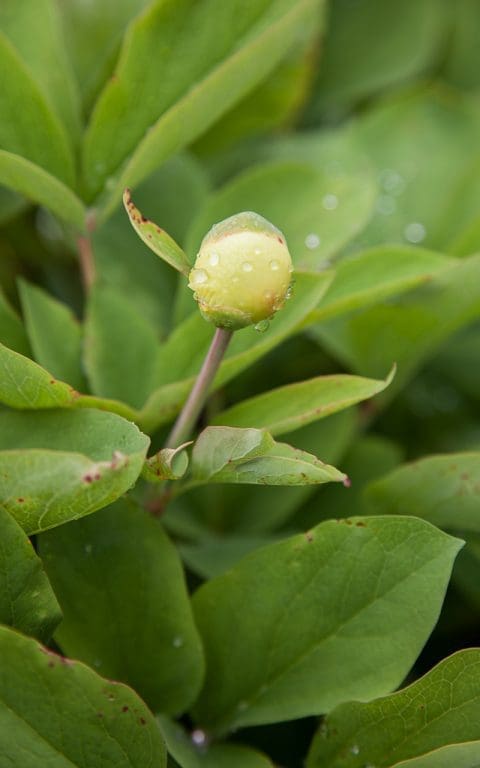
It takes time to build a good plant, for ‘Molly the Witch’ is slow and measured in her progress. Fortunately she is reliable if you find the right position and will survive for decades with no fuss. Growing in the wild in the Caucasus between the Black and the Caspian Seas, Paeonia mlokosewitchii favours rocky slopes in woods of oak and hornbeam, sometimes beech. I’d love to see them there and imagine that they must find the glades where early light penetrates and where they occupy the good ground away from too much root competition.
My eldest plants here are now about twenty years old and represent a long-held desire to grow them. I fell under their spell as a student at Wisley, but until I had my own garden had never had a place, and consequently the time, to invest in growing them for myself. When I finally did get a large enough garden in Peckham I bought five year-old seedlings from a trusted supplier and planted them in the garden where they flowered and thrived amongst the coyote willow. I layered them with scarlet Tulipa sprengeri, clumping grasses, Crocosmia ‘Lucifer’ and evening primrose for later. I left a parent plant there when we moved in 2010, but they were the most treasured of the Ark that I brought with us to start the making of a garden here. I lifted them in autumn – when peonies should be moved, as they make their root growth when going into dormancy above ground and ahead of the fast spring emergence – the parent plants were put into a holding bed on the shady side of taller perennials whist I was planning the future garden. It is important to plant peonies at just the right depth, never too deep as this will cause a plant to be blind and not flower. For this reason I keep the mulch away from their crowns, though they do love an eiderdown of goodness to protect their tuberous roots from desiccation.
Although they probably have more sun than they would like on our south-facing slopes, our heavy ground suits them as it retains moisture. They also have the summer shade of taller perennials that grow up around them to emulate their natural woodland habitat. Right now they sit amonst shimmery Melica altissima ‘Alba’, Zizia aurea and Lunaria annua ‘Chedglow’, the lustrous, dark foliage of the Honesty throwing the luminous flowers of Molly into prominence. Veronicastrum, white willow herb and late aster will cast shadow and keep them nestled once the summer gets underway.
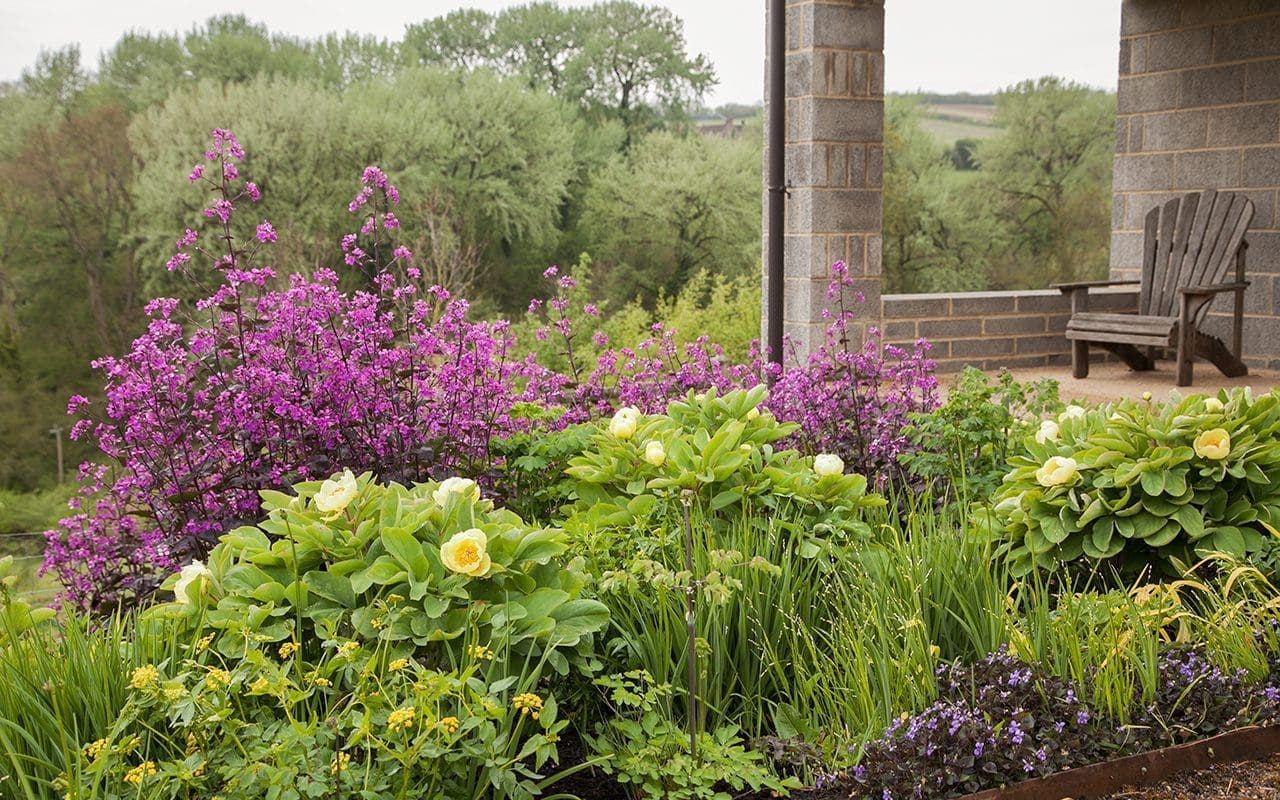
Collectively, my Mollies make a sizable group, the twenty year olds filling out to at least two feet across and bearing up to a dozen flowers each. I cannot help counting as each year brings more. One plant would have just as much magic, but an intergenerational mix with youngsters gives the impression that they are a colony that has increased over time. I am doing this more and more in the garden, dividing perennials but leaving some in the group to hint to the succession you’d find in the wild.
The plants that set seed remind you to revisit in the autumn to find the fat pods rupturing to reveal satin pink interiors and inky black seed, the size of peas. The seed must be sown fresh otherwise it goes into an enforced dormancy that is hard to break. The reserves in the seed are needed for the two years they take to germinate above ground The root develops in the first year to find its feet, waiting another before sending up a distinctive pinkish leaf. You have a wait ahead of you if you start from seed, but I can assure you that the prospect of building my family of plants has never felt like an uncomfortable wait. It has been one with a reward that never dims.
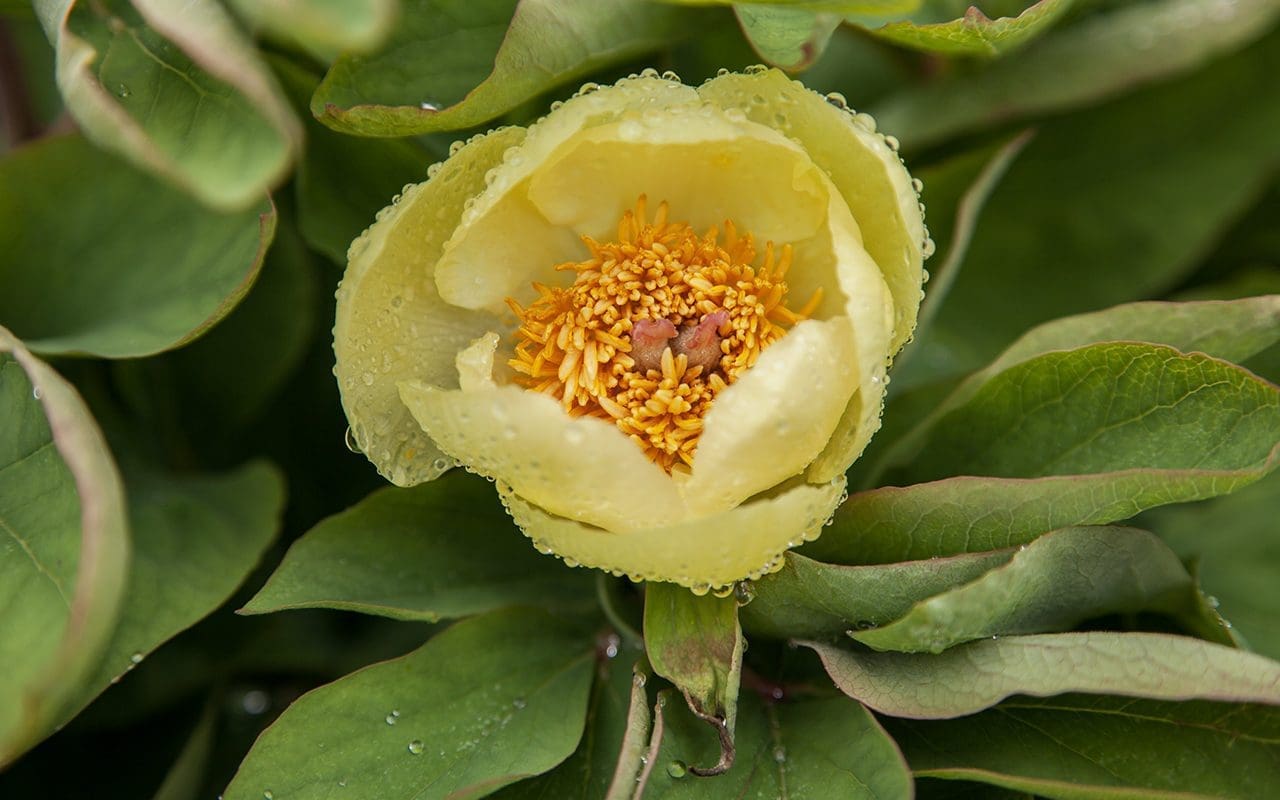
Words: Dan Pearson | Photographs: Huw Morgan
Published 18 April 2020
I was watching closely this year as the buds on the tree peonies started to swell. My plants needed to be moved from the stock-bed to their final positions in the new garden and it was critical that the timing was right. They have sentimental value, for I collected the originals as seedlings that were springing up under their parents at the Edinburgh Botanic Gardens. I was 19 and working under Ron McBeath, a great adventurer and plant collector in his own right and a man who understood that, if you fell for a plant, it was an all-consuming thing. It was tacitly acknowledged that a certain amount of ‘pockle’ (the term for spare plants for the taking) was tolerated. In fact, I had an orange crate strapped to the back of my bike for such booty. The seedlings were our morning’s weeding so a clutch made their way back to my digs, and then to my parents’ garden, before I was able to take them on to my garden in Peckham a good fifteen years later.
From there they came here as a new generation of seedlings which I’d been growing on just in case. Although they take up to five or six years to flower, growing from seed is easy enough if you sow it fresh as soon as it drops. Germination happens six weeks or so afterwards, but only underground. The first leaves don’t show themselves above ground until the following spring. I left them in the cold frame for a couple of years, as the young roots resent disturbance, and they were lined out here in the stock beds and flowered a couple of years after we moved in. Each plant has subtle differences – the joy of raising from seed – but all are as captivating as the original I now saw thirty-four years ago.
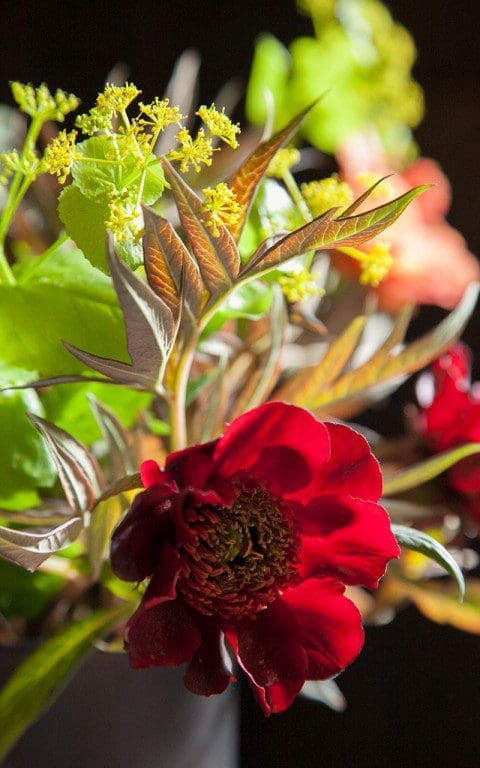 Paeonia delavayi and Smyrnium perfoliatum
Paeonia delavayi and Smyrnium perfoliatum
I have half a dozen Paeonia delavayi in their new positions, stepped through the entrance to the garden from the house to form a gateway of sorts. Although I wasn’t ready to move the plants until the end of winter, they were dug carefully with a decent root-ball to minimise disturbance. The move happened as soon as I saw the buds swelling, so that they would have the energy of growth on their side and not sit and sulk in wet soil.
Read up about moving peonies and most literature says they are hypersensitive and prone to failure and, if you do succeed, they take a long time to establish. It is also recommended to move them in the autumn, so that the early growth is supported by roots which have been active the winter long and can support this early flush of activity. However, my plants have proven all of the above to be rules worth bending.
Growth is famously early, fat buds breaking ahead of almost everything else and making them vulnerable, you might think, to the cruelty of March and April weather. Again, according to the books, you are supposed to plant tree peonies in positions where the early growth isn’t caught by morning sunshine which, in combination with a freeze, is lethal. A slow thaw is better but, miraculously, our plants were all untouched by a vicious frost last week that toasted the Katsura down by the stream and wilted the early growth on the campion in the hedgerow, so I believe them to be tougher than the hybrid Moutan peonies, their more exotic cousins.
Growing in pine clearings in Yunnan and Eastern Asia, Paeonia delavayi is more adaptable than you might first imagine. Edge of woodland conditions suit it best, but here, on our retentive soil, it has been happy out in the open with all-day sun and freely moving air on the slopes to confound best-practice positioning. I do like contradictions and the ever-evolving learning curve when you get to know your plants and their limits.
Standing in glorious isolation, and ahead of the planting which will join them in this part of the garden in the autumn, I am free to admire their form and am imagining their companions; the things that will complement their moody atmosphere and rich colouring when it comes to planting time. Tall, rangy stems, that will eventually reach six foot or so and as much across as they mature, give way to elegantly furling growth at the tips. The flowers, of darkest blood-red and with stiff, waxy petals, appear before the leaves are fully expanded, hanging at a tilt to hide the boss of red-flushed stamens which age to gold. The beautifully dissected foliage is coppery-bronze at this stage with a damson-grey bloom that fades to a matt neutral green as it fills out.
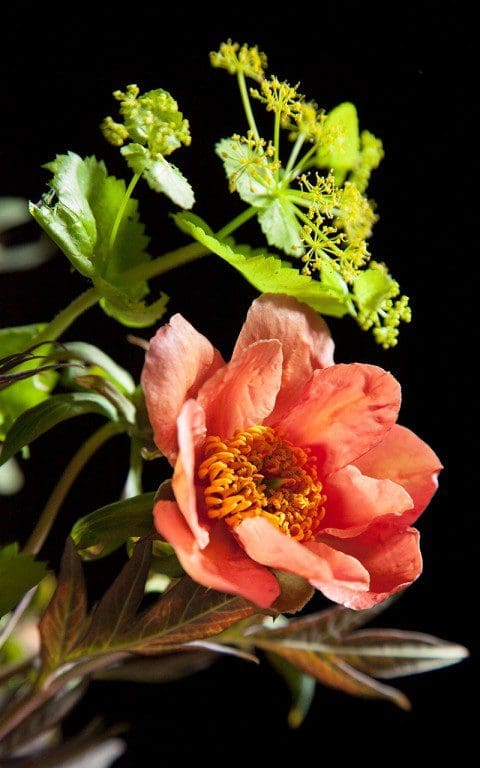 Paeonia potaninii and Smyrnium perfoliatum
Paeonia potaninii and Smyrnium perfoliatum
Paeonia potaninii, which hails from Western China and Tibet and is thought by some to be a subspecies of P. delavayi, is similar in its growth, but differs in its gently suckering habit. My original seedling, still growing in the dappled shade of my parents’ orchard, is now several feet across. It looks happy in the clearing and is competitive enough to deal with the infestation of ground elder and ferns that have made the orchard their territory.
Here conditions couldn’t be more different, but my plants show their adaptability by flowering more profusely and being less lush in leaf out in the open. The flowers are the most extraordinary confection of apricot overlaid with burnt sugar, like shot silk surrounding decorative saffron stamens. The flowers hang heavy amongst the new leaves and cast a strong perfume as you pass on the path. The distinctive scent has something of the citrus spice of witch hazel, but overlaid with an exotic, grassy sweetness. Cut, in a vase, their perfume is more easily savoured.
We have them here with the acid-yellow Smyrnium perfoliatum, which lifts the subtlety of the colour and throws it into relief. I’ll need to do this in the garden too and plan to have the darkness of P. delavayi amongst Anthriscus sylvestris ‘Raven’s Wing’, with P. potaninii floating above the ruby-red droplets of Dicentra formosa ‘Bacchanal’.
Though the brilliance of the Smyrnium is perfectly pitched with these rich, warm colours, I take heed from Beth Chatto’s words when I told her it hadn’t yet taken off in my garden in Peckham. ‘Just you wait !’, she said. And I, not wanting to break all the rules, have remembered her advice and have only set it free on the rough ground behind the barns with the comfrey.
Words: Dan Pearson / Photographs: Huw Morgan
We are sorry but the page you are looking for does not exist. You could return to the homepage